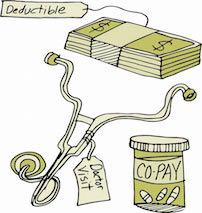
When The Onion published this satirical article “Company’s HR Manager Really Pushing Infinite-Deductible Health Care Plan” 2½ years ago, it was in response to the increased prevalence of High Deductible Health Plans from being a very small fraction of plans in 2005 (covering less than 2 million lives) to 20 million lives, a tenfold increase, by 2016.
Of those, nearly 14 million lives in HSA/HDHPs were in large group plans.
Source: AHIP Report. 2016 Survey of Health Savings Account - High Deductible Health Plans. February 2017.
Although the trend has since flattened, the burden of cost continues to shift toward patients in the form of higher coinsurance, copays, and out-of-pocket maximums.
Those needing expensive specialty medications have been hit especially hard by the ever-increasing deductibles and out-of-pocket (OOP) expenses.
Source: Kaiser/HRET Employer Health Benefits 2017
Manufacturers Strike
To counter the increased cost burden on patients for access to branded drugs, manufacturers invested exponentially more funds in Patient Assistance Programs that ballooned from covering 100 drugs in 2009 to 700 drugs in 2016, a $7 billion wager to reduce the cost burden on patients and drive sales to their products. These programs include copay cards among other methods, to cover the copays and coinsurance burdens for branded drugs up until their deductible and/or OOP maximum has been reached, at which point the health plan benefit kicks in.
Health Plans Hit Back
Just as copay assistance programs improve patient access to specialty medications, they also “effectively subvert the payor formulary cost-sharing.” With benefits designed to hold members accountable for roughly $4K annually, copay cards can leave members responsible for numbers as low as $30 annually. If the stakeholder who is making the cost decisions (the patient) does not bear any of the cost risk, they will not be incentivized to consider cost in their choice.
Enter the Copay Accumulator
With strict formularies and higher cost-sharing strategies showing mixed results in steering patients towards less costly care, some PBMs such as Express Scripts and Unitedhealth's Optum are now launching copay accumulator programs. This benefit design redefines OOP maximums and deductibles to exclude drug copayment liabilities covered by copay assistance programs.
One PBM serving employers, Script Care, argued in this recent press release that copay accumulators represent a strategy to more fairly distribute the burden of cost:
“Our copay assistance accumulator tracks a member’s actual out-of-pocket costs, ensuring that both members and employers contribute their fair share. Meanwhile, manufacturer co-pay assistance for the member continues as usual.”
In practice, some patients are nearly certain to end up either with sticker shock or, worse, abandoning therapy altogether (which in turn also could hurt plans through declining medication adherence rates). This is least likely in life-threatening conditions where patients have other support mechanisms to keep them on therapy, and most likely for specialty therapies in chronic conditions like psoriasis or RA where patients might stop without fatal risks.
How Will Manufacturers Strike Back?
Understandably, manufacturers hope to prevent widespread adoption of copay accumulator programs which have thus far been limited to PBMs. An example is a recent advocacy effort via Abbvie’s “Rx Benefits Brief” for employers. The brief includes an illustrative case study of a theoretical member being prescribed an RA specialty medication. The cost burden shifts from $60/year for the member with copay assistance (despite a $4,000 deductible) to $3,995 after a benefit design with a copay accumulator excludes the copay assistance from its OOP calculations.
The brief closes with the following advice to employers: “Don’t force your members to face a “co-pay surprise.” Consider the unintended consequences that may be the end product of an accumulator adjuster program.”
Values to Unite All Stakeholders
The issue not being directly addressed: the value of a medication to someone who can afford to share the cost burden is different than it is to someone who can’t and therefore the benefit design needs to be different. For those who can afford the cost-sharing inherent in their benefit design, cost-sharing incentives work to drive them to appropriate care based on need. However, when members who cannot afford a high cost burden get diagnosed with a disease with high medication costs, they are left without the ability to pay for it without assistance and more likely to have adherence problems.
Meanwhile, a life-saving medication remains invaluable to the individual as well as to society, but needs to be affordable.
Abbvie’s Rx Benefits Brief suggests several mechanisms by which employers can address this issue. And, one suggestion distributes the financial burden between employees rather than employers: base deductibles on income, with low wage workers facing lower deductibles.
Another approach to copay assistance is being proposed by advocates of value-based models: create alignment between cost, access and value of treatments with what the Center for Value-based insurance Design calls “Precision Patient Assistance Programs”. This includes tactics such as limiting copay accumulator programs to those that are clinically necessary and/or when utilization of the treatment will ultimately benefit the patient and the plan financially.
This could mitigate most issues, but imagine a $5B pill that prevented death regardless of the condition: how could a society or health plan cover that treatment, or build it into a the cost-sharing? Perhaps the real solution would be an infinity deductible plan after all?

